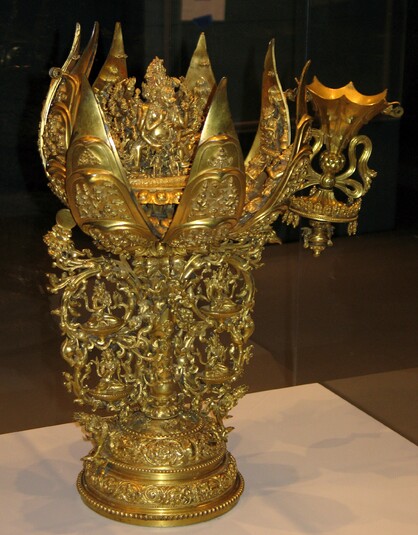
Item: Vajrabhairava (Buddhist Deity)
| Origin Location | China |
|---|---|
| Date Range | 1400 - 1499 |
| Lineages | Buddhist |
| Material | Copper |
| Collection | Private |
| Catalogue # | Tibet Museum, Lhasa |
Classification: Deity
Vajrabhairava Ekavira (Tibetan: dor je jig je, pa wo chig pa. English: The Solitary Hero Vajra Terror) a wrathful form of Manjushri.
Video: Vajrabhairava Lotus Mandalas (HAR on Patreon)
As a tutelary deity Vajrabhairava, also known as Yamantaka, belongs to the Bhairava and Yamari class of tantras and specifically arises from the Vajrabhairava Root Tantra (Tibetan: jig je tsa gyu). All of those Tantras belong to the method (father) classification of Anuttaryoga Tantra. The practice of Bhairava is common to the three Sarma (new) Schools: Sakya, Kagyu and Gelugpa. Among the Sakya it is counted as one of the four main tantric deities along with Hevajra, Guhyasamaja and Chakrasamvara (Tibetan: gyu de shi). Amongst the various Kagyu Schools the Drigungpa have been strong upholders of the practice. There are numerous forms and styles of practice from the very complex with numerous deities to the very concise with a single Heruka form.
Jeff Watt 6-2005
This three-dimensional, gilt copper alloy lotus mandala is based on a lotus-shaped prototype from the Pala kingdom of Eastern India (8th - 11th century). The bull-headed Vajra Terror (Vajrabhairava) rests within a lotus bud that rises above a filigreed stem with branches bearing images of offering goddesses and serpent figures.
This elaborate gilt artifact was a gift from the Ming Emperor Yongle (reigned 1403-1424), who cultivated the relationship of the Chinese imperial court with Tibet?s great Lamas, by means of a carefully orchestrated program of invitations to the Ming capitals at Nanjing and Beijing and repeated gift-giving. This three-dimensional mandala was once kept on the third floor of the Potala Palace.
The meditational deity Vajra Terror has nine heads, thirty-four arms and sixteen legs; each displays a different attribute. All of these attributes are part of the mnemonic device, the personification of the Vajrabhairava Tantra text. The metaphor of the practice of Vajra Terror is death; the death of the person, the moment, the ego, and so forth. (Text courtesy of the Rubin Museum of Art).
Exhibition: Tibet, Treasures from the Roof of the World
Thematic Sets
Subject: Eight Siddhas In One Painting
Buddhist Deity: Vajrabhairava, Sculpture
Buddhist Deity: Vajrabhairava (Sculpture Masterworks)
Buddhist Deity: Vajrabhairava (Sculpture Masterworks, China)
Buddhist Deity: Vajrabhairava Religious Context
Buddhist Deity: Deities (Yongle)
Buddhist Deity: Vajrabhairava (Early Works, Sculpture)
Sculpture: Yongle & Xuande Style (Masterworks)
Sculpture: Lotus Mandala Main Page
Sculpture: Yongle Style, Xuande & Zhengtong Period
Buddhist Deity: Vajrabhairava Main Page







